Taking a closer look at LHC
LHC works with proton (or lead nuclei) that are accelerated to speeds close to the speed of light. By letting very fast and energetic particles collide in the center of detectors, the scientists can extract information about matters smallest components. In such collisions are new particles created, which will provide information about the secrets of particle physics. In some sense the big accelerators can be said to be today's "super microscopes".
In the LHC proton bunches are accelerated (over a period of 25 minutes) to their peak 7-TeV energy, and finally circulated for 10 hours while collisions occur at the four intersection points.
26659 / 7,5 ~ 3550 bunches.
To get a correct sequence of bunches injected into the ring and to be able to insert new bunches when non-useful ones are extracted it´s necessary to allow enough space for that.
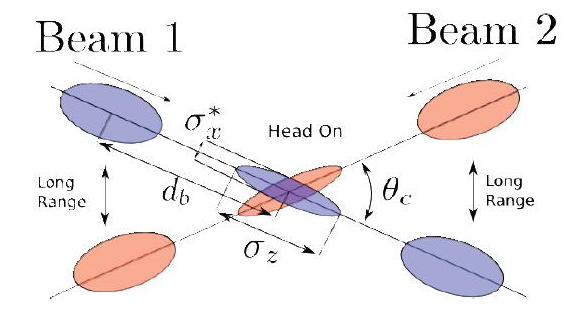
For the calculation we take into account the fact that there are 1,15·1011 protons per bunch (in LHC Run 3 -from 2022 to 2026- up to 1.8 × 1011 protons per bunch are reached). In order to understand this value, it should be noted that 1 cm3 STP of hydrogen has ~1019 protons).
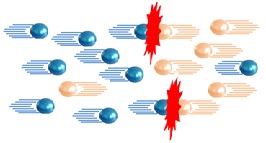
The "volume occupied" for each proton in the inteaction point is:
(74800x16x16) / (1,15·1011) ~ 10-4 μm3
That’s much bigger than an atom!, so a collision is still rare.
But when done ...
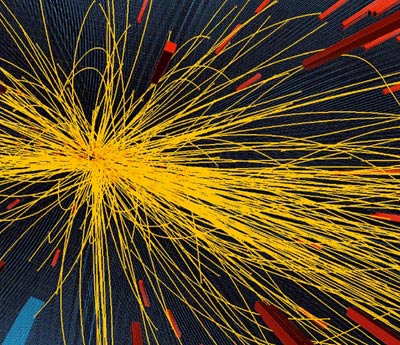
A 7 TeV proton–proton collision in CMS yielding more than 100 charged particles.
(CERN COURIER, October 26, 2010)
The probability of one particular proton in a bunch coming from the left hitting a particular proton in a bunch coming from the right depends roughly on the rate of proton size (d2 with d~1 fm) and the cross-sectional size of the bunch (σ2, with σ =16 microns) in the interaction point.
But with 1,15·1011 protons/bunch a good number of interactions will be possible every crossing.
Now, the number of interactions will be:
Probability x N2 (with N = number of protons per bunch)
So, (4·10-21) x ( 1,15·1011)2 ⇒ ~ 50 interactions every crossing
But just a fraction of these interactions (~50 %) are inelastic scatterings that give rise to particles at sufficient high angles with respect to the beam axis.
Therefore, there are about 20 "effective" collisions every crossing.
With 11245 crosses per second we get:
11245 x 2808 = 31,6 millions crosses , the "average crossing rate".
(31,6·106crosses/s) x (20 collisions/cross) ⇒ 600 millions collision/s
If we consider 3550 bunches: 11245 x 3550 = 40 millions crosses ⇒ 40 MHz
Every time two bunches of protons pass each other, some of the protons will collide at very high energy: primary vertices. At maximum Luminosity a lot of primary vertices are expected (pile-up vertices).
(About "pile-up" see more here...)
From these primary vertices secondary vertices are created and so on.
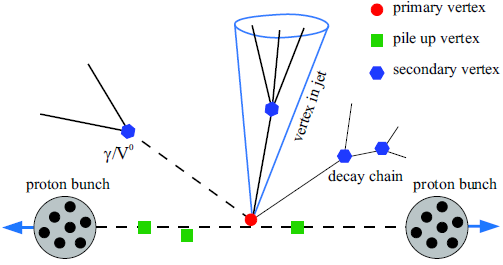
The less energetic primary vertices (generally no interesting) are not taking into account and only the most energetic primary vertix is considered.
In the harsh environment of the Large Hadron Collider at CERN efficient reconstruction of the signal primary vertex is crucial for many physics analyses. The track reconstruction algorithms are charged to carry out this selection.
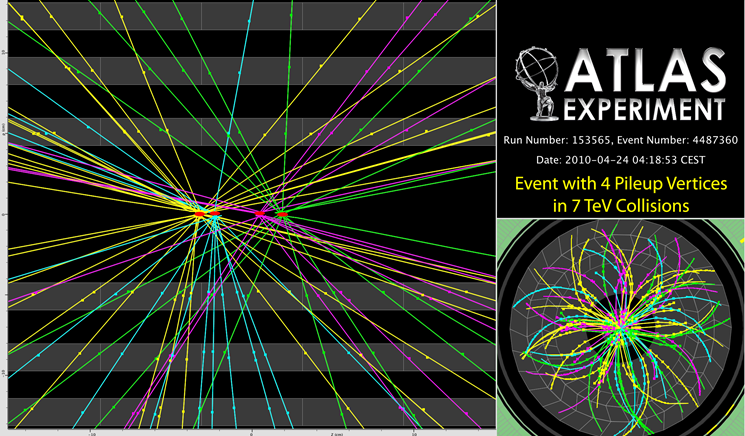
Event with four Pile-up Vertices ATLAS April 24th - 2010.
|
AUTHORS Xabier Cid Vidal, PhD in experimental Particle Physics for Santiago University (USC). Research Fellow in experimental Particle Physics at CERN from January 2013 to Decembre 2015. He was until 2022 linked to the Department of Particle Physics of the USC as a "Juan de La Cierva", "Ramon y Cajal" fellow (Spanish Postdoctoral Senior Grants), and Associate Professor. Since 2023 is Senior Lecturer in that Department.(ORCID). Ramon Cid Manzano, until his retirement in 2020 was secondary school Physics Teacher at IES de SAR (Santiago - Spain), and part-time Lecturer (Profesor Asociado) in Faculty of Education at the University of Santiago (Spain). He has a Degree in Physics and a Degree in Chemistry, and he is PhD for Santiago University (USC) (ORCID). |
CERN CERN Experimental Physics Department CERN and the Environment |
LHC |
IMPORTANT NOTICE
For the bibliography used when writing this Section please go to the References Section
© Xabier Cid Vidal & Ramon Cid - rcid@lhc-closer.es | SANTIAGO (SPAIN) |



